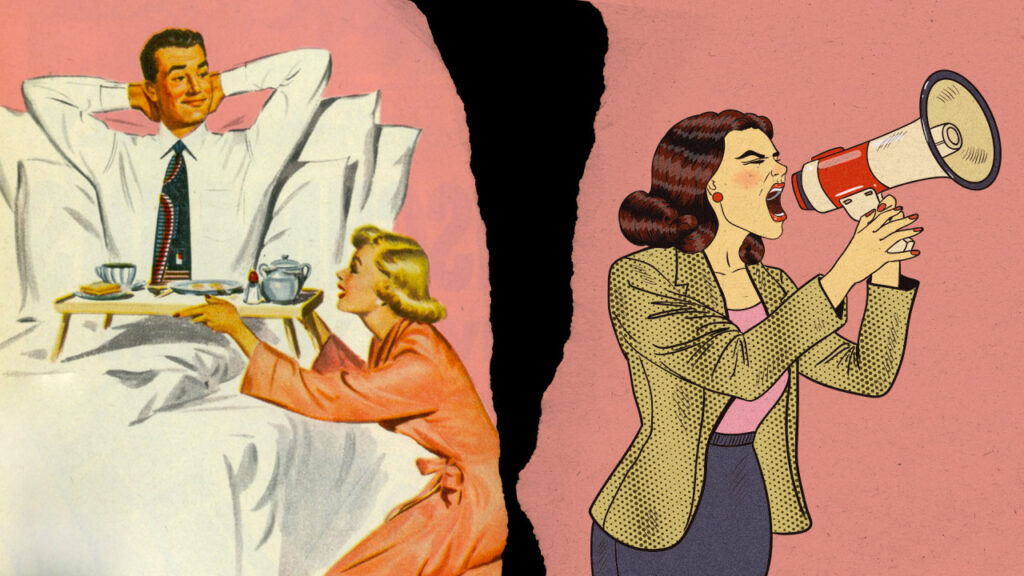In Spain, during the dictatorship of Francisco Franco, women would address their sentimental doubts and confidences to the radio programme of Elena Francis. She was nothing but a pseudonymous for a team of people belonging to Franco’s circle worried by keeping women in the groove of fascist morality.
Now, forty years after its last episode, Elena Francis is not needed anymore. She has been replaced by a trend of women – on the rise on social media in the last few years – advocating for turning back to the traditional marriage, respectful of traditional gender roles and of values as submissiveness and chastity.
These women are called tradwives – a neologism coming from the union of traditional and wives. Essentially homemakers, their prime lifegoal is to build a loving and serene home environment: this involves perfectly managing the house, raising children (often many) and serving their husband, who on his part plays the role of breadwinner. In many cases such families are strictly Christian, and the Bible is the prime justification for any of their attitudes.
Their accounts are gaining popularity on social media, especially on TikTok. Not only: books have been written (as English etiquette: the motivation behind manners), blogs have been opened (e.g. The Darling Academy).
Whether on social platforms, personal websites or on paper, what they show is a day-to-day life made of cooking – which often means preparing food from scratch –, cleaning the house, caring for children and optionally homeschooling. And, ça va sans dire, cater to their man’s needs. Alongside, they tell episodes of daily life with moral lesson which are meant to work as a role modern for their (female) followers.
Usually, all the contents created find themselves against a background of mellifluous tone of voice, renamed as “fundie baby voice” and a reassuring, beige environment. Mostly they wear perfect make-up and modest but cute dresses. Of course, it’s not a homogeneous movement: some women stick more to a cottage-core style, other hark back to 1950s’ traditional housewife aesthetic.
The reasons behind such a choice are different; they could span from the refusal of the career woman’s lifestyle to a cultural factor, being some of them grown up in a ultra-Christian context.
The tradlife choice is at least controversial. First, it implies a contradiction. These women want to reproduce a life model authentic, genuine and natural: the one of women before they entered the labour market. Let’s assume for a moment that life of women was peaceful and serene (and not a breeding ground for abuses). Even with such an assumption, the bucolic ideal stops being authentic, genuine and natural in the very same moment in which everything – from the tone of voice to the clothes, to the whole aesthetics – is set up. Rather than the daily life what is shown it’s a gilded version of it. Moreover, they preach for a lifestyle that is viable just for few: living with only one income it’s a luxury that no many can afford. Maybe tradlife influencer cannot either, since they monetise their contents and earn from their accounts.
Tradlife becomes even more problematic when it is related to feminism(s). As the British tradwife Alena Kate Pettitt recalls in her blog, «feminism is about choice». Precisely for the importance of being able to choose, deciding to give up one’s own financial independence is dangerous: it means being in a situation that cannot be left, not in case of discomfort, nor in case of abuses. Tradwives could represent an example of a conscious choice of submission, thus conveying an old and dangerous model, including restrictions of independence and loss of opportunity to socialise. Moreover, feminisms are many. Some have individual self-determination as a goal, others mean feminism as a collective movement aiming at changing the broader patriarchal context that produces individual choices.
However, one of the most interesting causes leading to the adoption of this life is fleeing the pressure of the current labour market. Here we are back to the dichotomy individual/collective. Avoiding in this way the problems of the labour market could be blamed of individualism: you save yourself without attempting to improve the collective context. Anyway, no one chooses which world living, and the effort for improvement should be a choice. On the other hand, it is an analysis-worthy argument. Nowadays job’s impact on mental health is an issue. The job context is often draining and exhausting and this results in chronic stress condition: the burn-out. If this is an a-gendered question, meaning that it affects both men and women, when it comes to the female situation it intersects with other issues: the gender pay gap and the care workload. Let’s leave aside the well-known question of the gender pay gap, which adds to work-related stress a lack of remuneration and acknowledgement. As for gendered care-work, the EIGE (European Institute for Gender Equality) reports that 34% of women cares for children or elderly, against 25% of men. The gap is wider for chores: 63% of women does housework versus 36% of men.
Women’s entrance in the labour market – a great achievement indeed – has happened without a shift in the division of care-work: women keep doing the bulk of work at home. As a result, women end up making two jobs, one of which is unrecognised at all, and the other is still less recognised than their male fellows’, due to gender pay gap.
Estee Williams, American ultra-Christian and far-right tradwife, explains why «tradwife content is blowing up all of a sudden» on her Instagram account of 120k followers. Among the causes, «we have a whole generation of women that are burnt out being a provider then coming home to be a homemaker».
Under this light, although it remains problematic and non-agreeable, tradwifery choice becomes more understandable: at least it raises a point that society should address.



